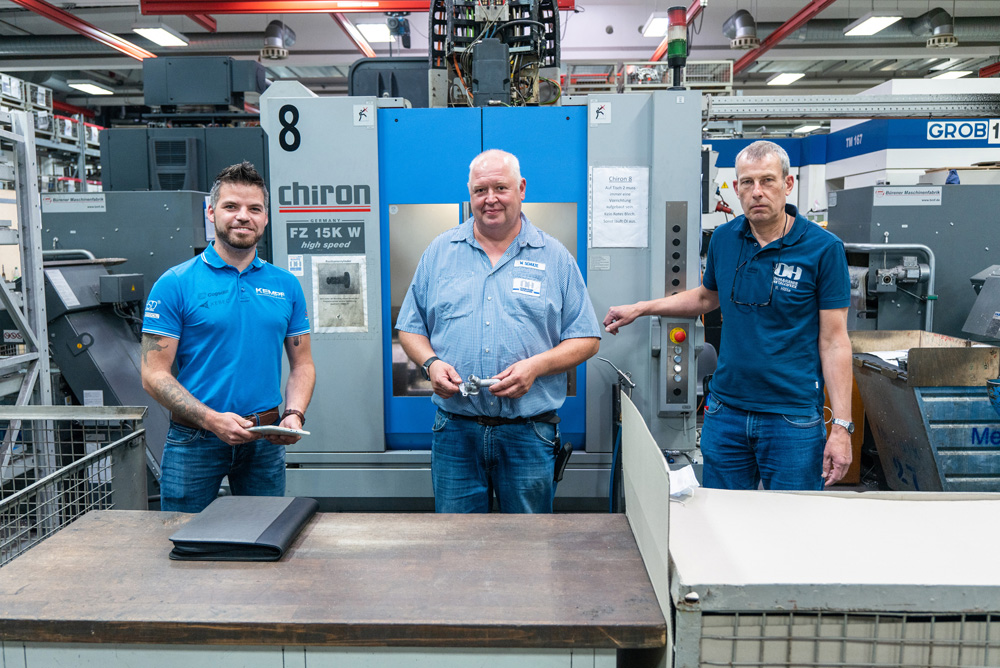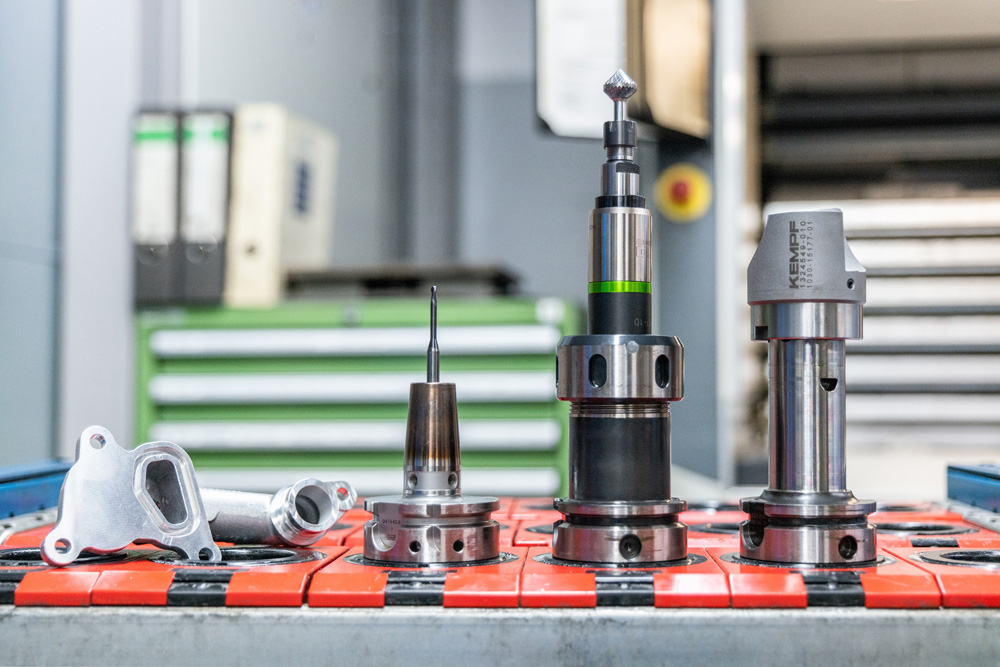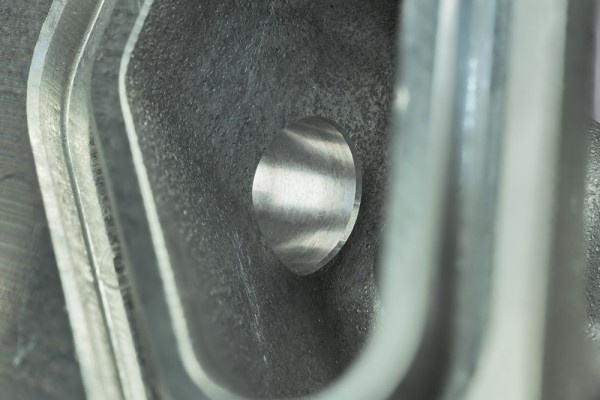As a specialist for non-ferrous castings, the family-owned company Ohm&Häner Metallwerk GmbH & Co. KG, based in the tranquil town of Olpe in the Sauerland region of Germany, has been a globally sought-after service provider and supplier to the medical technology, railroad technology, construction machinery and, to a degree of around 30%, the automotive sector since its foundation in 1961. What started back then with the construction of the first factory hall and the first aluminum melting furnace in own performance, has developed over the decades into a company with meanwhile 580 employees, which today acts as a specialist for small and medium series. Production starts with a quantity of 1 piece up to an average annual requirement of 40,000 pieces in the area of complete aluminum production.
The company's structures offer so much flexibility that up to 400 new parts are developed and produced each year, including many prototypes and very small series, for example also for high-engine sports cars, which are produced in manageable quantities. Components used in this area in particular have to meet very high quality standards and maintain them throughout the entire production cycle. Since lightweight construction is obligatory for such vehicles or even for future e-mobility, aluminum is naturally also a material that the specialists at Ohm&Häner shape into the desired form. Complete 3D simulations of the casting process, in-house clamping devices and a separate department for optimization and design are prerequisites that have been created to guarantee these standards.
For a complex automotive component made of cast aluminum, which is to be produced in a medium-sized series of about 400,000 units over seven years, the required defined deburring of two internal transverse bores, which have an asymmetrical contour, was initially missing for final approval. In addition, due to the comparatively high number of pieces, the complete machining, including deburring, was to be carried out fully automatically directly in the machine. Despite a large number of tests with different tools on the market, no deburring results meeting the requirements could be achieved.
Back-Burr Cutter & Path Deburring System from KEMPF as the only solution
Only after contacting the sales representative Max Staab of the deburring specialist KEMPF GmbH from Reichenbach-Fils, who has been known and appreciated for decades as a competent and respected contact in the metal cutting industry, a suitable solution could actually be found. Thereby, the specialist for special tools and deburring solutions attaches particular importance to the economic efficiency of the offered products.
By using the "Back-Burr Cutter & Path Deburring System", which consists of a spiralized and highly heat-resistant ball cutter and an NC data set generated specifically for the application, bore overlaps, thread exits and almost any complex contours can be deburred in a defined manner and in a replicable manner over a long machining time. The Back-Burr Cutter & Path deburring system is the first choice, especially when components are to leave the production line cost-efficiently, fully automated and without manual post-processing. This is because, in contrast to the deburring tools often used, which perform a linear movement in relation to the transverse bore and rotate in the process, the deburring system uses a more effective variant - namely contour-parallel deburring along the edge or contour to be machined. This means that different tool diameters and the associated time-consuming tool changes are not necessarily required for different bore diameters, because ideally several bore diameters from as little as 0.9 mm can be machined with one ball cutter. Due to the individual creation of the data set, the milling cutter traverses the contour of the component to be deburred with high precision and thus removes burrs that have arisen safely and without leaving any residue, even on the reverse side of bores. In principle, it is irrelevant how large the burr of the pre-machining is and which contour shape is to be deburred.
Long service life and consistent quality exceeds all expectations
A novelty and an unique selling point of the Back-Burr Cutter & Path deburring system lies in the NC data set, which simultaneously shifts the cutter cutting point to the component as standard during machining, so that punctual wear is prevented and an immense increase in tool life is achieved.
At Ohm&Häner, too, the deburring system was completely convincing and exceeded all expectations with its performance. The desired machining operations were carried out reliably and with consistent quality over many thousands of components, and the overall time required for component machining was significantly improved. Although the machine time required increased from 1:00 min to 1:24 min, this was more than compensated for by the elimination of all manual activities (for deburring and inspection). Due to the technical deburring solution, the entire detachable burr could be removed without time-consuming intermediate steps in the machine, which resulted in an immense cost advantage.
KEMPF with unique selling proposition in the area of deburring tools
Especially companies that are looking for savings potential and further optimization possibilities in any respect due to cost pressure or increasing requirements and have not been able to find a corresponding solution on the market so far, are best advised with the described deburring system. All programming efforts are taken over by KEMPF, so that the customer gets a deburring system which promises highest performance at low effort right from the start.
The deburring specialist KEMPF not only proves with this innovative system that there are almost no deburring tasks that cannot be performed directly on the machine. Further deburring with tools from KEMPF was finally also carried out on the mounting flange of the component and, with the help of a spring-loaded deburring cutter, was also carried out process-safely and quickly. In addition to the deburring tools used, a PCD bell tool designed by KEMPF was also convincing, combining several operations for machining the filler neck and also leaving no burr. The tool ordered by Ohm&Häner at short notice was designed and delivered by KEMPF within a very short time, so that the planned start of production could be kept and the customer could be spared unnecessary time and cost pressure.
Burr-free directly from the machine
Since the use of the tooling solutions, especially in the area of deburring, the component can be produced at Ohm&Häner without any manual work and thus with consistent quality. This primarily ensures not only lower costs and a faster throughput time, but also fewer complaints.
KEMPF as a supplier of these tools, draws on decades of experience in this field and a correspondingly large range of tooling solutions. The machining spectrum is diverse, but so are the tools. Because apart from the mostly "simple" applications, there are nevertheless repeated inquiries from customers who, due to almost inaccessible bore overlaps or complex contours, cannot fall back on a standard tool or the previous tool solutions simply do not provide a process-safe, defined and, above all, secondary burr-free result. KEMPF proved to be a competent solution finder for Ohm&Häner as well, beyond the standard portfolio of many competitors, and helped the customer to achieve a burr-free component directly from the machine, despite difficult conditions.
 |
Im Grunde eine unmögliche Entgratung mit herkömmlichen, sich rotierenden Entgratwerkzeugen. Nur im Zusammenspiel von Entgratfräser und CNC-Programm lässt sich eine solche asymmetrische Kontur entgraten. Eigentlich bieten dabei Aluminiumgussteile nicht die nötigen Voraussetzungen, um eine definierte Entgratung mit dem Back-Burr Cutter & Path Entgratsysstem replizierbar durchzuführen. Dennoch war der Kunde begeistert und kein anderes Entgratwerkzeug konnte die gewünschte Entgratung dieser innenliegenden Bohrungsüberschneidung in der vorausgesetzten Qualität innerhalb des Bearbeitungsprozesses durchführen. |
 |
Der technische Außendienst von KEMPF Max Staab, Winfried Schulte und Raimund Hütte von Ohm&Häner, die in der Prototypenentwicklung auch viele Bauteile für die Automobilindustrie entwickeln. Nach mehreren Versuchen mit Werkzeugen von Mitbewerbern konnte letzten Endes nur das von KEMPF gelieferte Entgratsystem überzeugen. |
 |
Für das Bauteil (ganz links im Bild) kommt von KEMPF nicht nur das Back-Burr Cutter & Path Entgratsystem (Kugelfräser links) zum Einsatz. Für weitere Entgratbearbeitungen am Flansch des Bauteils wird ein federgelagerter Fräser verwendet (mittleres Werkzeug). Ebenso wurde von KEMPF nach Begutachtung des Bearbeitungsprozesses kurzfristig ein PKD-Glockenwerkzeug aus der großen Auswahl an Semi-Standard PKD-Werkzeugen zusammengestellt (rechts), welches komplett gratfrei arbeitet und deshalb keinerlei manuelle Tätigkeiten mehr am entsprechenden Bauteil vorgenommen werden müssen. |
|
Click here for the complete article in Werkzeug Technik, edition 192a |
As a specialist for non-ferrous castings, the family-owned company Ohm&Häner Metallwerk GmbH & Co. KG, based in the tranquil town of Olpe in the Sauerland region of Germany, has been a globally sought-after service provider and supplier to the medical technology, railroad technology, construction machinery and, to a degree of around 30%, the automotive sector since its foundation in 1961. What started back then with the construction of the first factory hall and the first aluminum melting furnace in own performance, has developed over the decades into a company with meanwhile 580 employees, which today acts as a specialist for small and medium series. Production starts with a quantity of 1 piece up to an average annual requirement of 40,000 pieces in the area of complete aluminum production.





